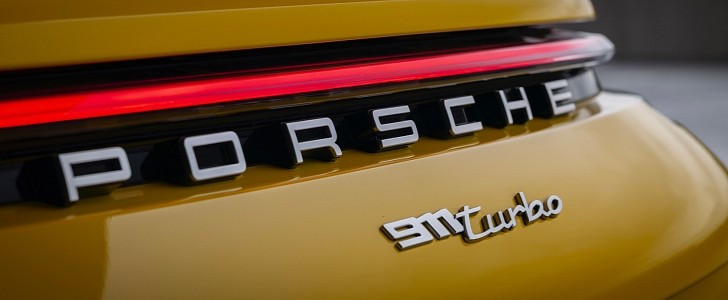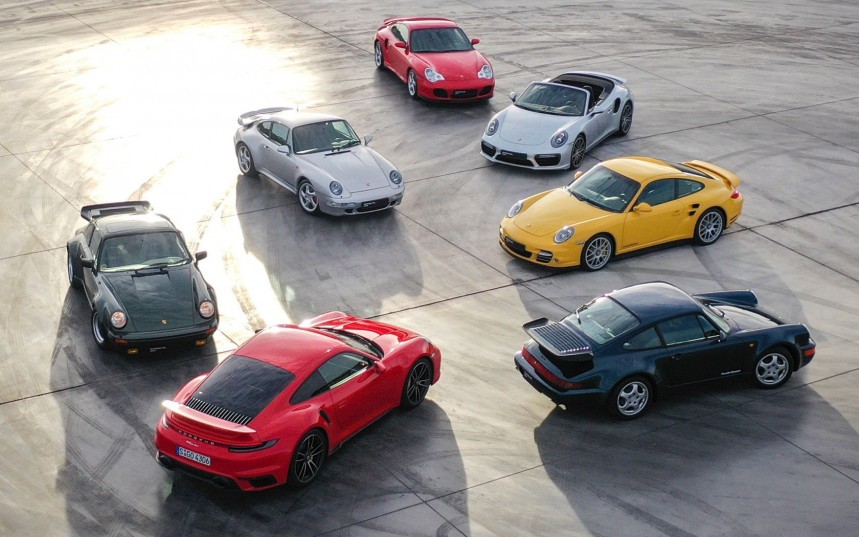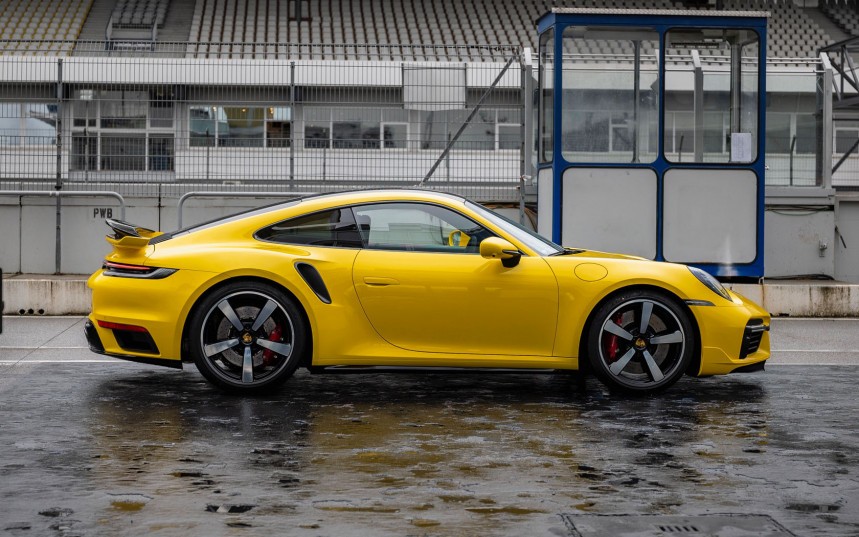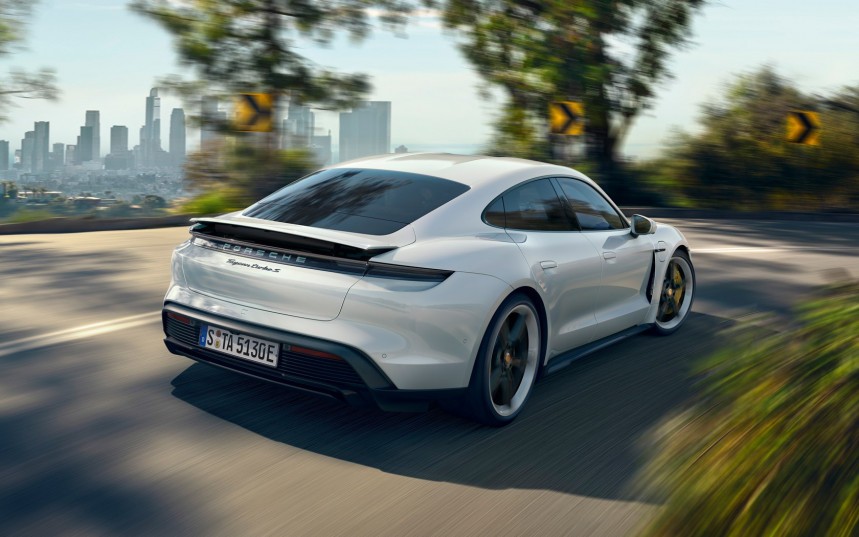The Taycan is the manufacturer’s first vehicle powered exclusively by an electric drive, yet top range models bare the ‘Turbo’ name, despite lacking a conventional combustion engine. This is because, for Porsche, the moniker stands for much more than a turbocharged engine.
Forty-five years have passed since the Zuffenhausen-based carmaker released the first turbocharged 911. It was the fastest production car available in Germany at the time and represented the brand's pinnacle of performance and technological advancements.
Since then, ‘Turbo’ grew to become more than a designation for Porsches powered by a turbocharged engine. It became synonymous with the fastest, most thrilling models, cars that spearheaded Porsche innovations from generation to generation.
The moniker blends the latest technological advancements with the legendary design and driving dynamics, establishing a strong connection between past, present, and the future. A Porsche bearing the Turbo badge is much more than just a flagship model though, it represents a principle of excellence.
Dr. Frank Walliser, Vice President for the 911 model line, describes it best: “A Turbo does not just have to be clearly different in visual terms, but it must above all be possible to really feel the difference. The work to differentiate is therefore correspondingly high, not just with regards to the design, but also to the chassis and the engine.”
The design of the new generation 911 Turbo (992) is a great example of this. Just like its predecessors, it features wide wheel arches, a large front spoiler, and the iconic rear wing that has been a signature for Turbo models throughout history.
But perhaps the most important characteristic that differentiates Turbos from all other Porsches is superior power. The current Turbo S features a newly designed 3.7-liter (3,745-cc) flat-six that represents a considerable step forward for the range, producing a massive 650 PS (478 kW; 641 hp) at 6,750 rpm. That’s 265 PS (195 kW; 262 hp) more than the ‘standard’ 992 Carrera.
Whether it’s turbocharging, all-wheel drive, adaptive aero, or cutting-edge braking systems, the Turbo has been a pioneer for new technologies for the last 45 years.
In the era of electrification, a great example of this is the Cayenne Turbo S E-Hybrid. It combines a capable V8 bi-turbo engine with a 100 kW (136 PS) electric motor for a combined output of 680 PS (500 kW; 671 hp).
That not only makes it one of the fastest SUVs out there and the unquestionable flagship of the Cayenne range but also showcases one of the most innovative PHEV powertrains in the industry.
Mind you, Porsche’s boldest statement in the new era is the groundbreaking Taycan. The carmaker’s first fully electric vehicle takes the Turbo principle to a new dimension.
The Turbo S is the alpha Taycan which uses a dual-motor layout and an 800-volt electric system that, along with its Performance Battery Plus, delivers 761 PS (560 kW; 751 hp) and 1,050 Nm (774 lb-ft) of torque.
It uses the latest technologies available like electronic AWD with torque vectoring or regenerative braking as well as advanced aerodynamics that led to one of the lowest drag coefficients of any current Porsche model.
In conclusion, ‘Turbo’ has become an important principle for the development of each Porsche model, and it transcends its literal sense. It will be a part of the carmaker’s future long after the turbocharger becomes a relic of the past.
Since then, ‘Turbo’ grew to become more than a designation for Porsches powered by a turbocharged engine. It became synonymous with the fastest, most thrilling models, cars that spearheaded Porsche innovations from generation to generation.
The moniker blends the latest technological advancements with the legendary design and driving dynamics, establishing a strong connection between past, present, and the future. A Porsche bearing the Turbo badge is much more than just a flagship model though, it represents a principle of excellence.
The design of the new generation 911 Turbo (992) is a great example of this. Just like its predecessors, it features wide wheel arches, a large front spoiler, and the iconic rear wing that has been a signature for Turbo models throughout history.
But perhaps the most important characteristic that differentiates Turbos from all other Porsches is superior power. The current Turbo S features a newly designed 3.7-liter (3,745-cc) flat-six that represents a considerable step forward for the range, producing a massive 650 PS (478 kW; 641 hp) at 6,750 rpm. That’s 265 PS (195 kW; 262 hp) more than the ‘standard’ 992 Carrera.
In the era of electrification, a great example of this is the Cayenne Turbo S E-Hybrid. It combines a capable V8 bi-turbo engine with a 100 kW (136 PS) electric motor for a combined output of 680 PS (500 kW; 671 hp).
That not only makes it one of the fastest SUVs out there and the unquestionable flagship of the Cayenne range but also showcases one of the most innovative PHEV powertrains in the industry.
Mind you, Porsche’s boldest statement in the new era is the groundbreaking Taycan. The carmaker’s first fully electric vehicle takes the Turbo principle to a new dimension.
It uses the latest technologies available like electronic AWD with torque vectoring or regenerative braking as well as advanced aerodynamics that led to one of the lowest drag coefficients of any current Porsche model.
In conclusion, ‘Turbo’ has become an important principle for the development of each Porsche model, and it transcends its literal sense. It will be a part of the carmaker’s future long after the turbocharger becomes a relic of the past.















